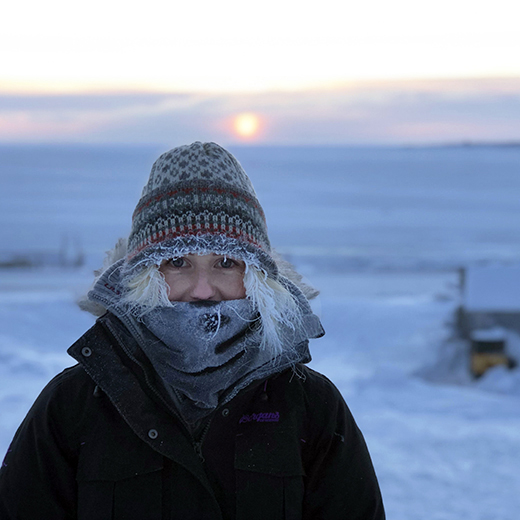USC student Kristin Emanuelsen isn’t batting an eyelid at the Sunshine Coast’s start to winter – she’s back from two months in temperatures more than 30 degrees below zero in the Canadian Arctic, where she learned handy traditions such as sewing winter mitts.
The 27-year-old Master of Arts student is experienced in acclimatising – she first came to USC from Norway in 2015 on a Study Abroad program to study sustainability and returned last year to study human geography with Dr Tristan Pearce and Dr Harriot Beazley of USC’s Sustainability Research Centre.
“Living in the Arctic for two months was wonderful. It’s forever changing and challenges your perspective on many things,” she said.
“It’s a beautiful, cold and raw place where people live in close connection with their environment.
“I sewed alongside Elders, learning special stitches for their winter mitts. I got to watch an Elder and her niece stretch a seal skin hide on the snow, using different tools to attach it to the ground, getting it ready to sew in the spring time.”
Kristin said her research topic, examining the importance of sewing to Inuit women, reflected her interest in sewing as well as her passion for the environment.
Senior Research Fellow Dr Pearce said Kristin and fellow USC Arts student Miguel van der Velden, 21, of the Caribbean island of Aruba, played key roles in a community-driven research project called Nunamin Illihakvia: Learning from the land.
The ongoing project, funded by Indigenous Services Canada, focuses on the transmission of knowledge and skills important for subsistence, including hunting food, sewing clothes and making tools.
It brings together Elders, experienced hunters and sewers to share knowledge and adapt to changing climate conditions.
Dr Pearce and the students participated in filming a video now on YouTube, featuring footage of the daily lives and environment of Ulukhaktok, an Inuit community of 400 people.
“This USC-led global project represents a new way of conducting research, in which the people who are the focus of the research govern the process, including the administration of funds,” he said.
“The team that travelled to the Arctic represent a larger network of Sustainability Research Centre academic staff, students and collaborators who are working with communities around the world on sustainability issues.”
Miguel van der Velden assisted in teaching a high school journalism class and documented the efforts of the local school to make education more culturally and socially relevant to Inuit students.
“In our second week, the whole class walked to a lake to cut ice for drinking water, which we then distributed to Elders and family members,” said Miguel, who recently completed his USC Bachelor of Arts majoring in journalism and sustainability and moved to Switzerland for an internship with the UN Environmental Program.
“I was interested in community-based research and the effects of environmental change and globalisation on Indigenous peoples because of my own Indigenous background in Venezuela.”
Media enquiries: Please contact the Media Team media@usc.edu.au

